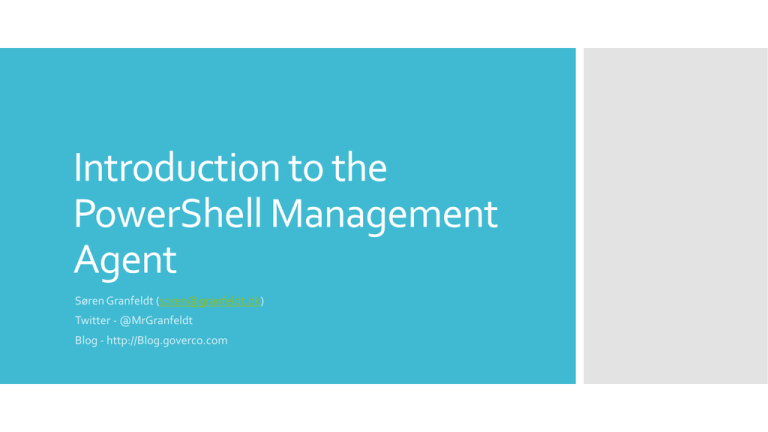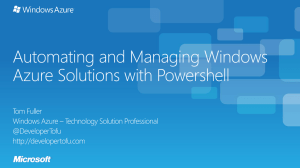psma-introduction
advertisement

Introduction to the
PowerShell Management
Agent
Søren Granfeldt (soren@granfeldt.dk)
Twitter - @MrGranfeldt
Blog - http://Blog.goverco.com
To create a management agent that could fit any MA needs not covered by built-in Management Agents
Every customer project has shown need for custom code and/or Management Agents and it was originally built as part of
customer project
I love PowerShell and the .NET Framework and all it’s possible magic
PowerShell’s pretty easy for it-pro’s to understand
If we can hit it with PowerShell, we can get at it with FIM, I tell my customers
A high interest from other customers and consultant helped decision make it publically available
Its free (http://blog.goverco.com/p/powershell-management-agent.html)
Current version is 4.5 but new version is coming soon
Built on ECMA2
Now part of every FIM project that I do – and used for managing a lot of systems
vision and
background
Proof-of-Concepts (PoC’s)
Office 365
SharePoint
User home/profile directories (have made som cool ones with DFS configuration and remote PS) - DEMO
SQL/Oracle (with delta support) - DEMO
Web services (REST/OData, SOAP etc.)
Plain text files with weird formatting and/or weel-structured XML files
Even Active Directory (as supplement to built-in ADMA)
Pictures (from share to FIM/Active Directory)
Has replaced a few advanced import and export flows (i.e. casing, normalizing and other formatting stuff)
Other uses –
ODBC with Lotus Notes / Kent Nordström - http://blog.konab.com/2013/04/using-powershell-ma-to-replace-ecma-1-0used-for-odbc/
HomeFolders / Kent Nordström - http://blog.konab.com/2013/03/homefolder-script-for-powershell-ma/
OpenLDAP / Kent Nordström - http://blog.konab.com/2013/02/replacing-openldap-ma-with-ps-ma/
Pictures / Remi Vandemir - http://www.iamblogg.com/2013/04/14/import-pictures-into-fim-portal/
One simple setup / install on your FIM sync box
Consists of a packaged MA
Supports
Full and delta import
paged import is supported from next version
Constructed anchor also supported in next version
Export
Password Management
Flexible schema
All functionality is in your PowerShell scripts; you need to be the PS guru
The technical
stuff
Schema
Import
Export
Password Management (optional)
You MUST know PowerShell to make the most of this MA – but then almost no
limits to functionality and creativity
All scripts are run in the security context of the Synchronization Service service
account, so make sure that the account can run scripts on your FIM box.
Alternative credentials can be specified on the MA and these are passed to all
scripts.
MA logging can be turned on through manual registry key
Automatic log file clean up may be in next version
Defines which attributes the MA has and your import/export scripts
can use
Called on configuration and on schema refreshes
Very simple syntax; just create one or more PSCustomObjects and
stick them into the pipeline
Sample script with two object types -
Schema script
$obj = New-Object -Type
$obj | Add-Member -Type
$obj | Add-Member -Type
$obj | Add-Member -Type
$obj | Add-Member -Type
Granfeldt”
$obj | Add-Member -Type
$obj | Add-Member -Type
$obj | Add-Member -Type
$obj | Add-Member -Type
$obj | Add-Member -Type
("Value1", "Value2")
$obj
PSCustomObject
NoteProperty -Name
NoteProperty -Name
NoteProperty -Name
NoteProperty -Name
"Anchor-Id|String" -Value 1
"objectClass|String" -Value "user”
"AccountName|String" -Value "SG”
”DisplayName|String" -Value "Soren
NoteProperty
NoteProperty
NoteProperty
NoteProperty
NoteProperty
"ObjectSID|Binary" -Value 0x10
"JustABoolean|Boolean" -Value $true
"Manager|Reference" -Value 2
"MemberOf|Reference[]" -Value (2,3)
”ProxyAddresses|String[]" -Value
$obj = New-Object
$obj | Add-Member
$obj | Add-Member
$obj | Add-Member
$obj | Add-Member
Department”
$obj | Add-Member
$obj
PSCustomObject
NoteProperty -Name
NoteProperty -Name
NoteProperty -Name
NoteProperty -Name
-Type
-Type
-Type
-Type
-Type
-Name
-Name
-Name
-Name
-Name
"Anchor-id|String" -Value 0x10
"objectClass|String" -Value ”group”
"AccountName|String" -Value ”group1”
”DisplayName|String" -Value ”Sales
-Type NoteProperty -Name "Members|Reference[]" -Value (2,3)
Called for each import operation
Takes five parameters –
$Username and $Password (configured on MA)
$OperationType (Full or Delta)
$UsePagedImport (boolean) (next version)
$PageSize (how many or less objects to return) (next version)
$global:RunStepCustomData value is passed between MA and import script.
Holds delta watermark (if you want to support delta)
Must be maintained by script
$global:PageToken value is passed between MA and import script.
Import script
Holds your paging token
You should stuff a hashtable object in the pipeline for each import object
Control values are in brackets - [DN], [ErrorName], [ErrorDetail]
To signal import success send ‘success’ text value in [ErrorName] or custom errormessage to signal import
failure
For delta deletes, return only anchor value, objectclass and special attribute ‘changeType’ with value
delete
A sample return hashtable with an import error may look like this $Obj = @{}
$Obj.Add("Id", "1")
$Obj.Add("[DN]", "CN=Luke Skywalker,OU=Normal Users,DC=domain,DC=com")
$Obj.Add("sAMAccountName", "LS")
$Obj.Add("[ErrorName]", "read-error")
$Obj.Add("[ErrorDetail]", "An permission error occurred during directory read")
$Obj
Called for each export operation
Export objects are batched in pipeline
Always paged (pagesize determined by Run Profile)
Object Replacements (no value means null/delete)
Script takes two parameters –
$Username and $Password (configured on MA)
Two flavors of export objects
Export script
CSEntryChange (see MSDN)
Simple object (PSCustomObject with all attributes and control values)
[Identifier], [Anchor], [DN], [ObjectType], [ChangedAttributeNames],
[AttributeNames], [ObjectModificationType]
Return hashtable object in the pipeline for status of each export
Control values [DN], [ErrorName], [ErrorDetail]
Next version will allow you to return datasource constructed anchor (SQL, Office
365 and other similar datasources)
A sample return hashtable object with no export error may look like this $status = @{}
$status."[Identifier]" = $identifier #the identifier (cs guid)
$status."[ErrorName]" = ”success”
$status."[ErrorDetail]" = ””
$status
• Script is called on password
changes and sets received
from Password Change
Notification Service (PCNS)
Password
Management
script
• If password change/set is
unsuccessful, just throw
error
•
PS C:\> throw “up” #or a bit
better description
• If not using PCNS, just
create empty script as MA
requires script file to exist
Demo
environment
FIM Synchronization Server (R2)
Flat file for HR data (has account name, first and lastname)
Default AD management agent
PowerShell MA for full/delta import and export to remote SQL
server with simple Stored Procedures for calculating users
displayname and home directory path
Some calculations could of course be done in FIM Service instead
PowerShell MA for home directory management
Imports users from AD and uses join (no provisioning)
Manages homeDrive and homeDirectory
No FIM Service or FIM portal
Provisioning is done using FIM Codeless Provisioning Framework
(https://fimmre.codeplex.com/) – simple XML rules and metaverse rules
extension
Now for the risky part of the presentation
– a live demo..!
Powerfull MA but you need to write solid PowerShell scripts for it
Gotcha’s
No space in script paths or use short path name
Set PowerShell Execution Policy for Synchronization Service service account
Later version may have option to select security context to run scripts (impersonate)
Error message ‘Unable to retrieve schema’ may be permission issue or plain error in schema
script
New version coming out soon
Wrap-up and
questions
Constructed anchors on import
Optional paged imports
Additional control values on Simple Export objects making it preferable in most cases
[Anchor], [ChangedAttributeNames], [AttributeNames]
A few bugfixes
Has really been very stable; most errors has been script errors
Support
No free direct support
FIM 2010 forum / PowerShell forums (I may just visit that from time to time)
Thanks for all ideas; they help shape the MA’s future
Mail ideas to soren@granfeldt.dk or Twitter DM @mrgranfeldt
Better yet – share them as comments on the blog for others to comment on as well











